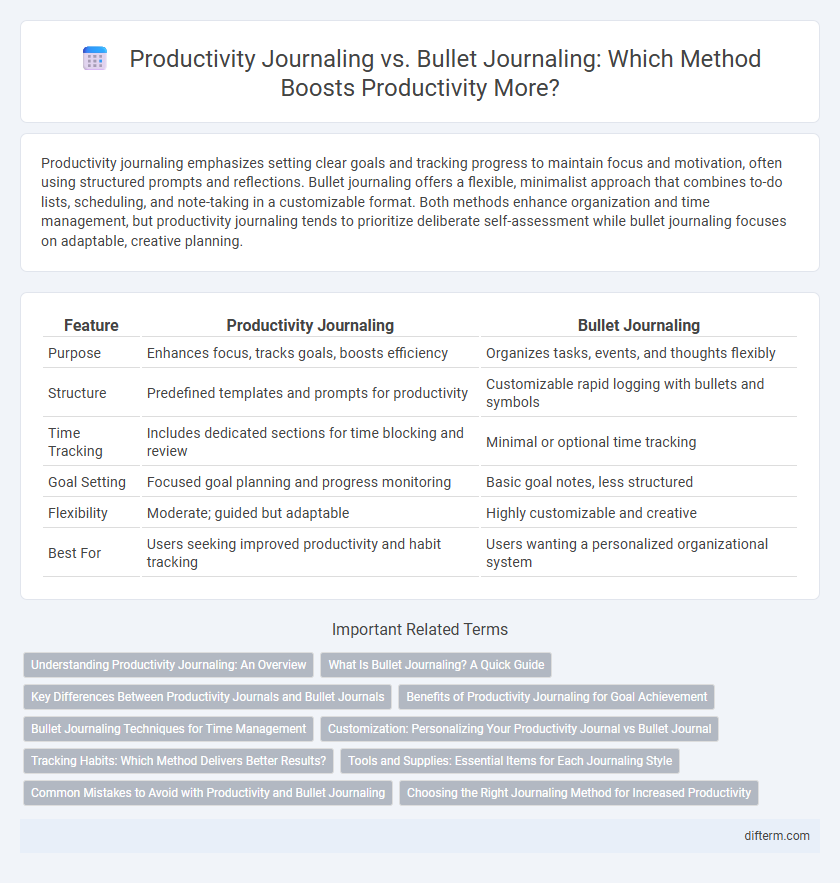Productivity journaling emphasizes setting clear goals and tracking progress to maintain focus and motivation, often using structured prompts and reflections. Bullet journaling offers a flexible, minimalist approach that combines to-do lists, scheduling, and note-taking in a customizable format. Both methods enhance organization and time management, but productivity journaling tends to prioritize deliberate self-assessment while bullet journaling focuses on adaptable, creative planning.
Table of Comparison
| Feature | Productivity Journaling | Bullet Journaling |
|---|---|---|
| Purpose | Enhances focus, tracks goals, boosts efficiency | Organizes tasks, events, and thoughts flexibly |
| Structure | Predefined templates and prompts for productivity | Customizable rapid logging with bullets and symbols |
| Time Tracking | Includes dedicated sections for time blocking and review | Minimal or optional time tracking |
| Goal Setting | Focused goal planning and progress monitoring | Basic goal notes, less structured |
| Flexibility | Moderate; guided but adaptable | Highly customizable and creative |
| Best For | Users seeking improved productivity and habit tracking | Users wanting a personalized organizational system |
Understanding Productivity Journaling: An Overview
Productivity journaling is a focused practice designed to enhance task management, goal tracking, and time optimization by systematically recording daily activities and reflections. Unlike bullet journaling, which emphasizes customizable layouts and creative elements, productivity journaling prioritizes structured entries that align with specific productivity frameworks such as the Eisenhower Matrix or Pomodoro Technique. This approach allows individuals to identify priorities, monitor progress in real-time, and adjust strategies for improved efficiency and goal attainment.
What Is Bullet Journaling? A Quick Guide
Bullet journaling is a customizable organizational system that combines task lists, calendars, and notes into one streamlined notebook. It uses symbols and rapid logging techniques to track productivity, goals, and daily activities efficiently. This method enhances focus and flexibility, making it ideal for managing tasks and personal growth compared to traditional productivity journaling.
Key Differences Between Productivity Journals and Bullet Journals
Productivity journaling centers on tracking specific goals, deadlines, and task completion using structured layouts designed for efficiency and accountability. Bullet journaling employs a customizable, rapid logging format with symbols and short entries to capture tasks, events, and notes, emphasizing flexibility and creativity. The key differences lie in productivity journaling's goal-oriented, data-driven approach versus bullet journaling's adaptable, minimalist system that combines planning with personal reflection.
Benefits of Productivity Journaling for Goal Achievement
Productivity journaling enhances goal achievement by providing structured daily reflections and progress tracking that increase focus and accountability. Unlike bullet journaling, which emphasizes flexible organization and creativity, productivity journaling integrates goal-setting frameworks such as SMART goals and time-blocking techniques to boost efficiency. This method supports continuous improvement through habit tracking and targeted task prioritization, leading to more consistent and measurable outcomes.
Bullet Journaling Techniques for Time Management
Bullet journaling techniques for time management prioritize rapid logging, customized task prioritization, and migration of unfinished tasks, enhancing focus and efficiency. Utilizing symbols like bullets, arrows, and exclamation points streamlines task tracking and deadline adherence, while module layouts such as daily logs, future logs, and monthly calendars provide a comprehensive overview. This structured yet flexible method contrasts with productivity journaling by offering a visually organized system that adapts to dynamic schedules and promotes consistent progress evaluation.
Customization: Personalizing Your Productivity Journal vs Bullet Journal
Productivity journaling offers extensive customization through tailored templates and goal-specific layouts that adapt to unique work habits, enhancing focus and efficiency. Bullet journaling emphasizes modular design with rapid logging and flexible indexing, allowing users to create personalized collections and trackers that reflect their evolving priorities. Both methods facilitate personalization, but productivity journaling often provides more structured guidance for achieving specific outcomes, whereas bullet journaling excels in adaptability and creative freedom.
Tracking Habits: Which Method Delivers Better Results?
Productivity journaling excels in habit tracking by focusing on detailed daily reflections, allowing users to identify patterns and make targeted improvements over time. Bullet journaling offers a flexible, customizable format with habit trackers that provide a clear visual overview of progress, enhancing motivation through simplicity and consistent monitoring. Studies indicate that combining structured tracking from productivity journaling with the visual clarity of bullet journals yields superior habit formation and sustained productivity gains.
Tools and Supplies: Essential Items for Each Journaling Style
Productivity journaling requires tools such as goal-setting templates, habit trackers, and productivity planners designed to streamline task management and progress tracking. Bullet journaling relies on customizable supplies like dotted notebooks, fine liners, and stencils that enable flexible layouts and rapid logging of errands, notes, and events. Essential items for productivity journaling emphasize structure and goal orientation, while bullet journaling tools prioritize creativity and adaptability.
Common Mistakes to Avoid with Productivity and Bullet Journaling
Common mistakes in productivity journaling include neglecting to set clear, achievable goals and failing to review entries regularly, which undermines progress tracking. Bullet journaling errors often involve overcomplicating layouts or inconsistent use of symbols, leading to decreased motivation and fragmented task management. Both methods benefit from simplicity, consistency, and prioritizing actionable tasks to enhance productivity effectively.
Choosing the Right Journaling Method for Increased Productivity
Productivity journaling emphasizes goal-setting, time management, and reflection to enhance focus and track progress, making it ideal for individuals seeking structured productivity improvement. Bullet journaling combines task management, calendars, and note-taking in a flexible, customizable system that adapts to varied personal and professional needs while fostering creativity. Selecting the right journaling method depends on whether the priority is systematic productivity tracking or a versatile, visual approach to organizing daily tasks and long-term objectives.
Productivity journaling vs Bullet journaling Infographic

 difterm.com
difterm.com